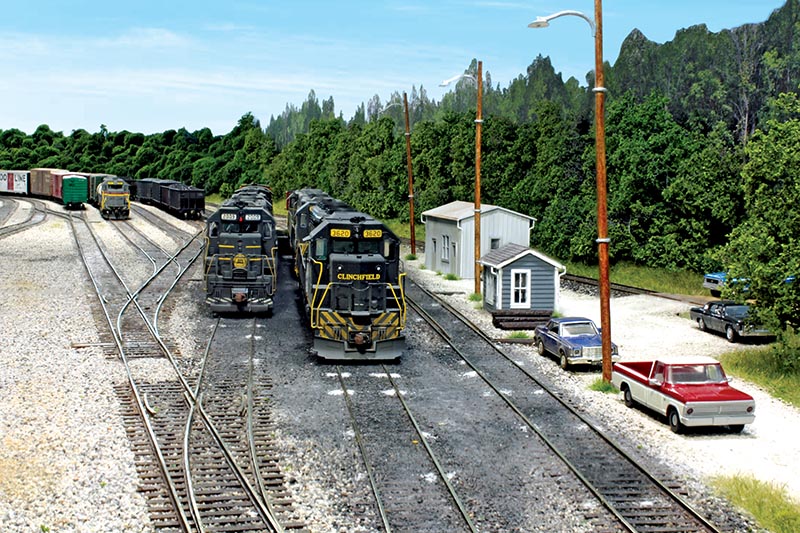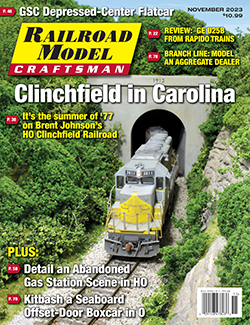 by Brent Johnson/photos by the author
by Brent Johnson/photos by the author
Appalachian railroading has been in my blood for as long as I can remember. My earliest memories of railroading originated from frequent trips visiting family in Harlan, Ky., where I had a front-porch view of the Louisville & Nashville’s Cumberland Valley Subdivision main line and its endless strings of coal trains. Having family who worked for the railroad also had its benefits, with an occasional cab ride or tour of the facilities.
Although these early experiences made me a lifelong fan of the L&N, it was the L&N and Atlantic Coast Line’s smaller subsidiary, the Clinchfield Railroad, that really grabbed my attention. My fascination with the Clinchfield began back in the mid-1980s. While snooping through some boxes at a friend’s house, I came across the November and December 1976 issues of Railroad Model Craftsman. Included in the pages of those magazines was a two-part series on the Clinchfield Railroad by David DeVault, Jim Boyd, and Tony Koester. Not long after I discovered those magazines, the book “Clinchfield Country,” by Steve King, was published. I became enamored by scenes of this small 277-mile mountain railroad that carved its way through the Appalachians by way of 56 tunnels, and through some beautiful scenery.
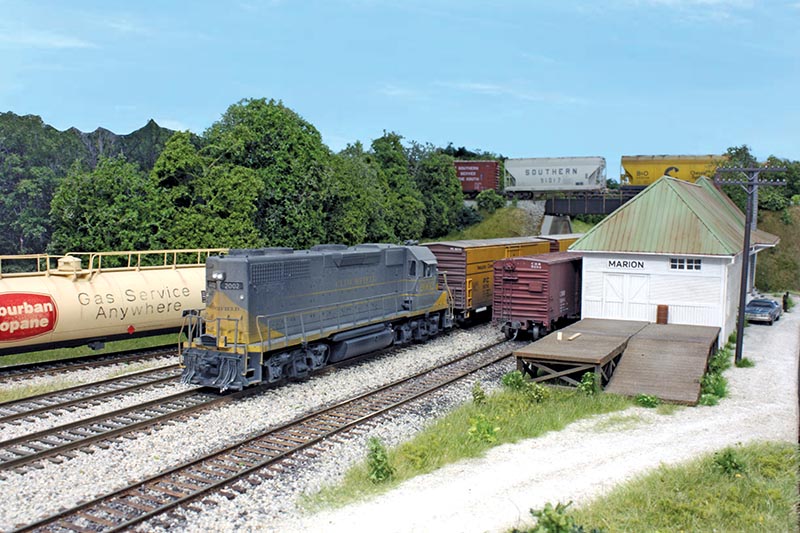
ABOVE: CRR GP38 2002 is handling the duties of the Marion Shifter as it pulls past the Marion depot and underneath the Southern Railway’s S Line.
A railroad running across the Blue Ridge Mountains was proposed as early as the 1860s, but the first construction of what would become the Clinchfield wouldn’t take place until 1900. By 1908 the Carolina, Clinchfield & Ohio was open from Johnson City, Tenn., to Marion, N.C. By 1915, the entire line ran from a connection with the Chesapeake & Ohio at Elkhorn City, Ky., all the way down to Spartanburg, S.C. Atlantic Coast Line and Louisville & Nashville began their joint lease of the line in 1924, renaming it the Clinchfield Railroad.
By 1972, L&N and Seaboard Coast Line (successor to ACL) began marketing their combined services as the “Family Lines,” along with the Clinchfield, Georgia Railroad, Atlanta & West Point, and Western Railway of Alabama. When the roads were merged at the end of 1982, the Clinchfield Railroad became the Clinchfield Subdivision of the new Seaboard System Railroad and, later, part of CSX Transportation.
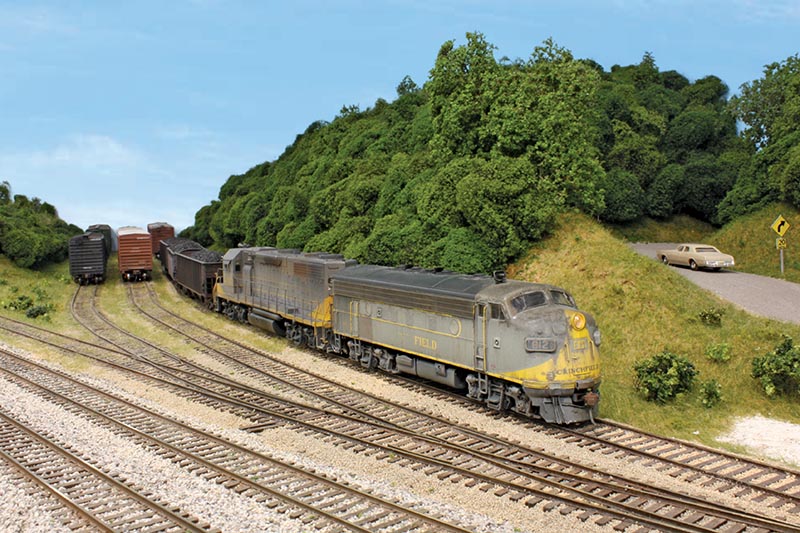
ABOVE: A CRR F7 and GP7 back a cut of hoppers into an interchange yard with the Southern Railway at Marion.
Don’t let its small size fool you — the Clinchfield was big-time mountain railroading. From hundred-car unit coal trains and hot shot named freights like the Florida Perishable, to “shifters” (locals) with catchy nicknames like “Jitterbug” and “Ridge Runner,” the Clinchfield had it all! Much of the L&N coal I saw rolling through Harlan as a kid was heading to the Clinchfield to be delivered to hungry power plants throughout the southeast. Modeling the Clinchfield was a win-win for me, and it became my goal to one day recreate this action in miniature.
Planning
The characteristics of the Clinchfield varied from one end to the other. Was I going to model the rich coal fields of the north end around Elkhorn City and Dante, or perhaps the industrial areas of Kingsport and Johnson City? After much thought, I settled on the south end of the railroad. This section from Erwin, Tenn., to Spartanburg, S.C., included a wide variety of industries and interchanges with other railroads. I settled on a date of June 1977, although I am flexible with some motive power and rolling stock by a year or two. I chose early summer of 1977 as it was just before the Clinchfield traded its seven General Electric U36Cs —the only non-EMD power on the roster — to the Seaboard Coast Line for a like number of EMD SD45s. There was also still a good mix of first-generation motive power mixed in with the newer second-generation power. The Clinchfield was known to grab whatever power was available; so, it’s not unlikely to have a consist of F-units mixed with Geeps, SDs, or U-boats. Power pooled from Family Lines members SCL and L&N was common during this era, which adds to operational interest.
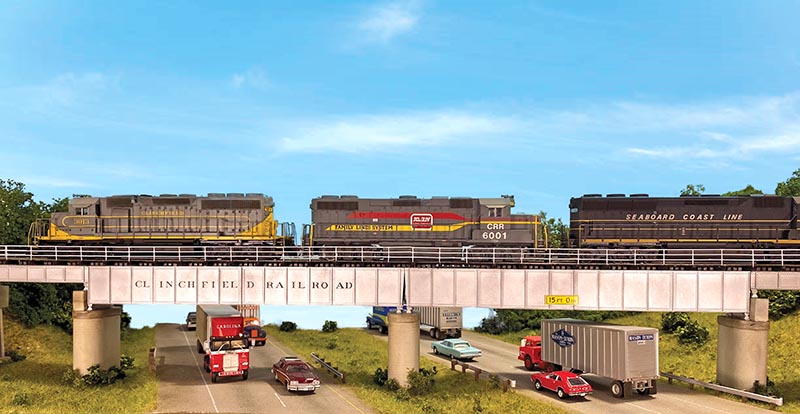
ABOVE: A northbound train led by Clinchfield SD40 3013, followed by CRR GP38-2 6001 and an SCL SD45 crosses I-85 near Spartanburg. Construction on this segment was completed in 1964, and was the first interstate highway across South Carolina.
Construction
Planning for the layout really took off in 2012, when my wife and I purchased a house with a large 35’x51’ unfinished basement. Using 3rd Planit track planning software, I began designing a double-deck layout that would fill this large basement. I wanted to avoid having trains disappear into a helix, so I designed the layout to continuously climb in order to gain elevation between the decks. Towns with rail-served businesses are level and the grade between them is between 1 and 1.5 percent.
Standards for trackwork are 36” minimum radius curves and turnouts no smaller than No. 6. I build most of my turnouts by hand using tools from FastTracks. I use MicroEngineering Code 83 flex track for the main line and Code 70 for sidings and yards.
My subroadbed is spline, using ¼” hardboard cut into 1-inch-wide strips. I have a local woodshop cut the spline strips for me as it saves me time and they are able to cut them perfectly. I use ¾” plywood subroadbed for towns and yards. Currently, track has been laid from Rocky to Bostic Yard on the upper deck, with most of it scenicked. Expansion has begun to complete the upper deck all the way to Spartanburg…


